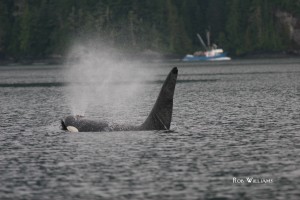 A lot of the research our charity, Oceans Initiative, conducts is to see how human activities — all of them — affect marine wildlife, both in the Pacific Northwest and around the world. The iconic orca we study illustrate this problem well. According to the latest census by Center for Whale Research, the population is hovering at 84 individuals. The original problem was a live capture fishery for display in aquaria, with all the direct and collateral damage that entailed. But why aren’t they recovering, nearly 40 years after the captures stopped? Regulatory agencies in Canada and the US agree: it’s a combination of lack of prey (Chinook salmon), too much noise, and chemical pollution. Some of these threats are much easier to manage in the real world than others. But are we focusing on the right threats?
A lot of the research our charity, Oceans Initiative, conducts is to see how human activities — all of them — affect marine wildlife, both in the Pacific Northwest and around the world. The iconic orca we study illustrate this problem well. According to the latest census by Center for Whale Research, the population is hovering at 84 individuals. The original problem was a live capture fishery for display in aquaria, with all the direct and collateral damage that entailed. But why aren’t they recovering, nearly 40 years after the captures stopped? Regulatory agencies in Canada and the US agree: it’s a combination of lack of prey (Chinook salmon), too much noise, and chemical pollution. Some of these threats are much easier to manage in the real world than others. But are we focusing on the right threats?
In our field, this thorny problem is described as “cumulative impacts of multiple anthropogenic stressors.” Clumsy, right? Our colleague, Dr David Bain, described it better: Which raindrop caused the flood?
It’s really, really hard to predict how wildlife populations will respond to a minefield of too much ocean noise, not enough food and a body full of chemicals. Think about that for a moment. The blubber that whales put on to survive — used by mothers to make milk for their young — is full of toxic chemicals, and the best way for a whale to detox is to transfer those pollutants to their offspring. Not great for the calf. Adult males don’t even have that option. And if you’re honest about the uncertainty in all the steps and how they fit together, your predictions span the entire range from no effect to catastrophic effects.
Our newest research proposes a way around it. Start at the end. Start by asking how much impact on endangered whale populations that our laws allow, and work backwards to calculate how much perturbation (noise, competition with fisheries) it would take to get there.
This approach doesn’t solve the problem, but it helps identify the problem, and the math is easier. For some critically endangered species, policy-makers may not want to allow ANY impact on a population. For healthy, growing populations, our laws allow some impact on marine mammal populations, because humans use the ocean too: for fishing, shipping, recreation, tourism and extracting energy. Our approach gives us a rough, ballpark estimate of what a healthy population can withstand. Then, you can convene a group of scientists, managers and stakeholders to ask how likely it is that the sum total of all current and proposed activities could cause us to be exceeding that threshold.
There are a number of places around the world where this sort of exercise is needed. As we try to ensure whale and dolphin populations recover from the Deepwater Horizon incident, it would be good to look at the cumulative effects of all activities, including seismic surveys, in the Gulf of Mexico. As we discuss opening new parts of the Arctic to oil and gas activities and shipping, we can use this method to test whether all of those activities, together, could affect food security of communities living in the Arctic. As we consider the number of industrial developments for the British Columbia coast — ports, liquefied natural gas terminals, pipelines and tanker traffic proposals — it may be time to consider how all of these factor may affect whale and dolphin populations. Some are doing fine. Others are barely hanging on. Our new tool can give us a starting point for discussion how much is too much.
We loved writing this paper with Dr Christopher Clark (an acoustician at Cornell University), Dr Len Thomas (a statistician at the University of St Andrews), and Prof Philip Hammond (a marine mammal population ecologist at the University of St Andrews). Please check out the #openaccess paper on the website of the journal, Marine Policy:
Gauging allowable harm limits to cumulative, sub-lethal effects of human activities on wildlife: A case-study approach using two whale populations

